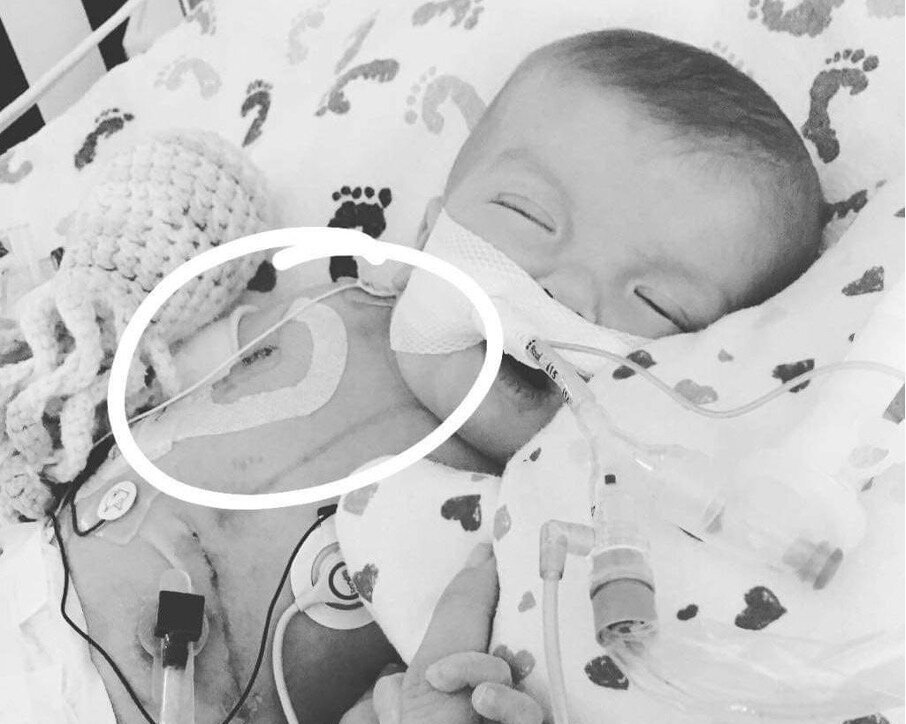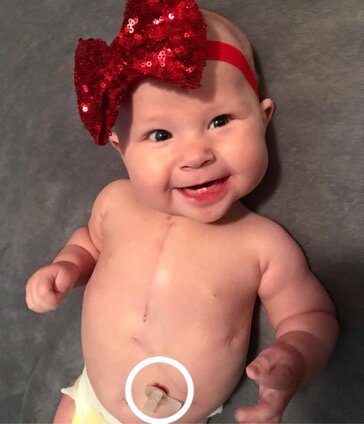CDH Equipment
Being in a hospital room loaded down with so many machines that it becomes nearly impossible to find the baby is a parent’s worst nightmare. Hospital equipment can be daunting, but knowing what each piece does helps make a stressful situation a more understanding situation. It can also help you learn to see past the machines so that you can focus on what truly matters—your baby!
Below are some pieces of equipment that you might see during an extensive hospital stay or maybe even a quick trip to the ER.
Extracorporeal Membrane Oxygenation (ECMO)
ECMO is heart lung bypass. During surgery the surgeon will attach two cannulas to your baby’s veins and arteries (usually in the neck). These cannulas connect to the machine that removes unoxygenated blood from your baby’s body, oxygenates it as the lungs would, and then pumps it back to the body. This is used to give the heart and lungs a chance to rest and get stronger, while ensuring the baby is getting the oxygen they need to survive and expel CO2 adequately.
Ventilator
A vent will help deliver breaths to your baby when their lungs are too small or weak to breathe independently. It helps open and close the lungs in a fashion that mimics actual breathing. Various settings will help deliver different types of breaths, pressure, etc. Babies on vents will often start on full support and then be gradually weaned down as they are able to take more and more breaths on their own.
Oscillator
An oscillator is a slightly more aggressive type of ventilator. It can be used when the conventional ventilator is not providing the necessary amount of pressure or support. The traditional ventilator opens and closes the lungs, whereas the oscillator shakes (oscillates) to keep the lungs open continuously, which helps diffuse gasses. It is often used as an attempt to avoid ECMO.
Continuous Positive Airway Pressure (CPAP)
Once your baby is off the ventilator and takes spontaneous breaths independently, they may be moved to a CPAP. This provides continuous mild air pressure to keep the airways open for babies that need help keeping their airway unobstructed.
PICC Line
A PICC line is similar to an IV; however, it is a long term line that will deliver medicine, fluids, or nutrition. This line is a central line that is placed in a vein that delivers blood to the heart. It can also be used for blood draws, such as labs or blood gases. It is placed in the baby’s arm or leg. Sometimes it takes more than one attempt to get a PICC line in place, so if they aren’t able to do it on the first attempt, try not to worry!
Nasal Cannulas
Once off of the vent and CPAP, babies will often graduate to nasal cannulas. The nasal cannulas are used when your baby can now take breaths on their own and do not need continuous pressure to keep airways unobstructed. It simply provides small amounts of supplemental oxygen until they can keep their sats up on room air. Your baby may come home with supplemental oxygen for a few months.
IV Pole and Pumps
An IV pole or several poles will have the pumps that deliver medicine or fluid to your baby. Early in a NICU stay, a CDH baby may have 10 or more IV pumps, but as time goes on, the number should lessen until the last pump is wheeled out and any required medicines are given orally.
ART Line
An arterial line will help measure blood pressure, as well as provide a line to gather arterial blood that is used to check for routine blood gases. Blood gasses are taken to measure the pH, O2, and CO2 in the blood. These numbers tell the doctors how well the baby is oxygenating and responding to treatment.
Intravenous Therapy (IV)
An IV can be placed to deliver medicine or fluids into the vein. An IV is a is a short-term line.
Broviac Line
A broviac line is very similar to a PICC line but placed in the chest. It is also a long term line.
Wound Vac
A wound vac might be used to help reduce swelling and pull fluid and bacteria from the wound.
Somanetics
This piece of equipment will measure cerebral oxygenation as well as kidney function. Monitoring these systems helps the doctors know if further intervention is needed and helps avoid adverse events from occurring.
NG/ND Tube
A nasogastric tube can be used for feeding. The tube is inserted through the nose and delivers food to the stomach. An ND will deliver food to the duodenum, which bypasses the stomach. A nasogastric tube can also be used to suction, which helps drain the stomach contents when necessary.
Isolette
An isolette is the bed the baby will be in. The isolette can be used to weigh the baby, measure their temperature, and has heating features. Depending on the situation, the isolette can be fully enclosed to ensure minimal stimulation or open.
G-Tube
A gastric tube can be placed to deliver food to the stomach when the baby is unable to eat on their own. This will be placed surgically if it is determined to be needed.
Monitors: These screens will display the patient’s vitals, like heart rate, blood pressure, respiratory rate, oxygen saturations (sats), and CO2 exchange. Each will have an acceptable range, and if your baby’s numbers fall outside of the range, you will hear alarms to alert the doctors and nurses. Try not to worry or watch the monitors too much, though. The beeping alarms often don’t mean much, and the medical staff will let you know when they matter. Focus primarily on your baby and how they look. That will usually give you a better indication of a true problem.
Leads
Leads are small stickers that are placed on the baby’s chest and abdomen. These monitor heart rate and respiratory rate and display them on your baby’s monitor.
Nitric Oxide
Nitric is delivered through a ventilator to help with respiratory distress. This is often done as an attempt to avoid going on ECMO.
Pulse Oximeter
A “pulse ox” measures oxygenation of the blood throughout the body. The sticker can be placed on the hand or foot. The reading from the pulse ox is the oxygen saturation (sats). This number will display on your baby’s monitor.
Chest Tubes
The chest tube is inserted between the lungs into the lining of the chest cavity. It is used when the doctors need to remove fluid, blood, or air from around your baby’s heart or lungs. It helps by allowing the lungs to fully expand.
Transcutaneous oxygen measurement (TCOM or TcPO2): TCOM is used to measure the oxygen level of the tissue below the skin and monitor CO2 levels. It will help the doctors know if your baby is adequately oxygenating and releasing CO2 correctly without having to wait for blood draws. If they aren’t exchanging gases well, the staff will be able to intervene more quickly.
It can be overwhelming at first to see your Tiny Hero hidden within a sea of machines. However, as the days go by, the machines are wheeled out one by one, and the lines are removed. Every time something disappears, the room grows, and it’s an indication that your baby is making tremendous progress!
A special thanks to Taylor Tatum and Olivia Cason for contributing content for What to Expect - CDH Equipment Explained.
Email stories@tinyhero.org to learn about how you can write for Tiny Hero.





















